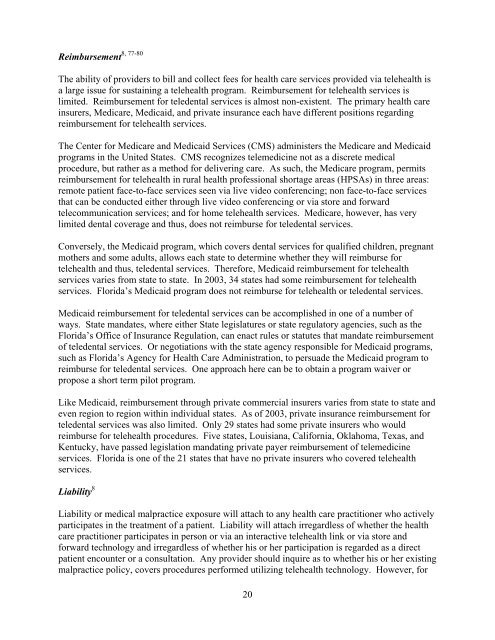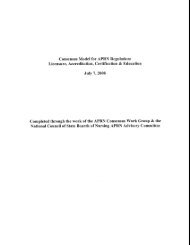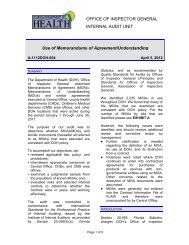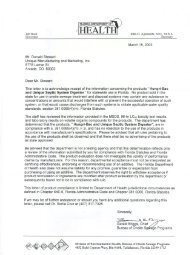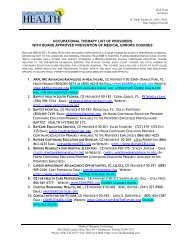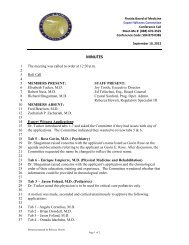White Paper - Florida Department of Health
White Paper - Florida Department of Health
White Paper - Florida Department of Health
You also want an ePaper? Increase the reach of your titles
YUMPU automatically turns print PDFs into web optimized ePapers that Google loves.
8, 77-80<br />
Reimbursement<br />
The ability <strong>of</strong> providers to bill and collect fees for health care services provided via telehealth is<br />
a large issue for sustaining a telehealth program. Reimbursement for telehealth services is<br />
limited. Reimbursement for teledental services is almost non-existent. The primary health care<br />
insurers, Medicare, Medicaid, and private insurance each have different positions regarding<br />
reimbursement for telehealth services.<br />
The Center for Medicare and Medicaid Services (CMS) administers the Medicare and Medicaid<br />
programs in the United States. CMS recognizes telemedicine not as a discrete medical<br />
procedure, but rather as a method for delivering care. As such, the Medicare program, permits<br />
reimbursement for telehealth in rural health pr<strong>of</strong>essional shortage areas (HPSAs) in three areas:<br />
remote patient face-to-face services seen via live video conferencing; non face-to-face services<br />
that can be conducted either through live video conferencing or via store and forward<br />
telecommunication services; and for home telehealth services. Medicare, however, has very<br />
limited dental coverage and thus, does not reimburse for teledental services.<br />
Conversely, the Medicaid program, which covers dental services for qualified children, pregnant<br />
mothers and some adults, allows each state to determine whether they will reimburse for<br />
telehealth and thus, teledental services. Therefore, Medicaid reimbursement for telehealth<br />
services varies from state to state. In 2003, 34 states had some reimbursement for telehealth<br />
services. <strong>Florida</strong>’s Medicaid program does not reimburse for telehealth or teledental services.<br />
Medicaid reimbursement for teledental services can be accomplished in one <strong>of</strong> a number <strong>of</strong><br />
ways. State mandates, where either State legislatures or state regulatory agencies, such as the<br />
<strong>Florida</strong>’s Office <strong>of</strong> Insurance Regulation, can enact rules or statutes that mandate reimbursement<br />
<strong>of</strong> teledental services. Or negotiations with the state agency responsible for Medicaid programs,<br />
such as <strong>Florida</strong>’s Agency for <strong>Health</strong> Care Administration, to persuade the Medicaid program to<br />
reimburse for teledental services. One approach here can be to obtain a program waiver or<br />
propose a short term pilot program.<br />
Like Medicaid, reimbursement through private commercial insurers varies from state to state and<br />
even region to region within individual states. As <strong>of</strong> 2003, private insurance reimbursement for<br />
teledental services was also limited. Only 29 states had some private insurers who would<br />
reimburse for telehealth procedures. Five states, Louisiana, California, Oklahoma, Texas, and<br />
Kentucky, have passed legislation mandating private payer reimbursement <strong>of</strong> telemedicine<br />
services. <strong>Florida</strong> is one <strong>of</strong> the 21 states that have no private insurers who covered telehealth<br />
services.<br />
Liability 8<br />
Liability or medical malpractice exposure will attach to any health care practitioner who actively<br />
participates in the treatment <strong>of</strong> a patient. Liability will attach irregardless <strong>of</strong> whether the health<br />
care practitioner participates in person or via an interactive telehealth link or via store and<br />
forward technology and irregardless <strong>of</strong> whether his or her participation is regarded as a direct<br />
patient encounter or a consultation. Any provider should inquire as to whether his or her existing<br />
malpractice policy, covers procedures performed utilizing telehealth technology. However, for<br />
20


